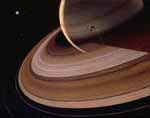The Social Dynamics of Binary Solar Systems
A recent study reports that binary-star planetary systems may be equally likely as single star systems to develop. As far as the geometry, the Space.com article three possibilities, based primarily on the distance separating the stellar pair. A close in pair might have a planetary system orbiting the center of gravity of the two stars, (giving you a Tatooine sunset). A pair with medium separation may be too unstable for planetary formation at all. And the third option is that the two stars may orbit far enough apart that they each have their own planetary systems in orbit around them.
It's this third option that I find most intriguing. Just as the Moon hangs tantalizingly close, in our sky, just asking to be flown to, imagine there was another entire solar system, a second sun 3-4 times the distance to pluto away. A good distance to be sure, but much more within reach than even Alpha Centauri. A tempting distance, especially if there were planets in it's habitable zone.
How much more eager would we be in that scenario to develop a real long-distance spaceflight capability? If there were colonies, the politics of the added distance would make it a much different dynamic than an outpost on Mars. Interesting stuff.


